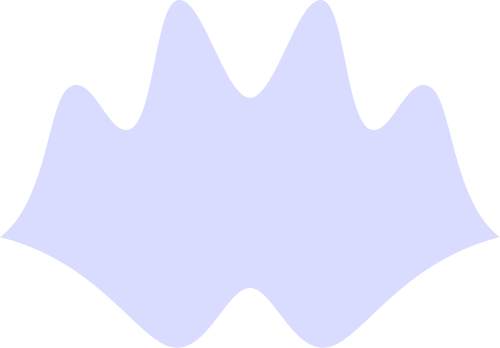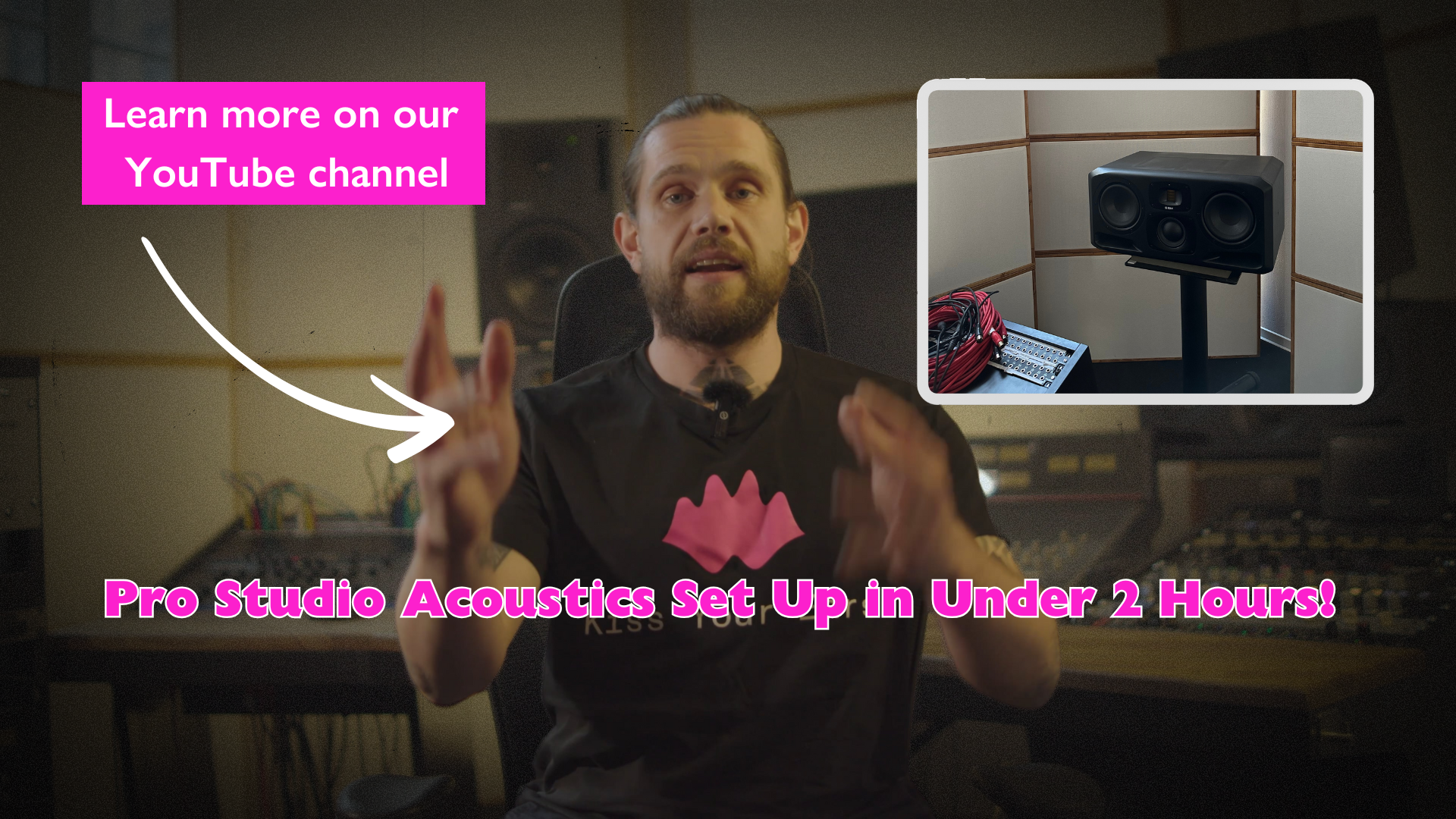Broadband vs Tuned Absorbers
If you have done a little research into the world of acoustics, you may already recognize a few of the different types of bass traps and treatment methods that exist, such as broadband absorbers, limp membrane absorbers, rigid membrane absorbers, helmholtz resonators, slotted panel resonators, diaphragmatic resonators and, well… the list goes on! What you may not know however is that they all function a little bit differently, and warrant a different price tag based on their materials and construction methods. Generally, bass traps and absorbers can be split into two different categories:
- Broadband (Velocity) Absorbers - Absorbers! These traps convert sound energy into heat energy through particulate velocity.
- Tuned (Pressure) Absorbers - Resonators! These are tuned traps that work to attenuate and diminish sound energy through resonance!
Which method is right for me? Well, that depends. However, in 99% of the cases we encounter, the preferred method of treatment favours the velocity absorption approach. Why is that?
Let’s investigate…
Broadband Absorbers
Broadband - Simply refers to the bandwidth or effective workable range of the absorber. Technically speaking, you could even have a tuned trap that is broadband, so long as its effective range covers a couple of thousand Hertz. A broadband trap or acoustic panel is simply anything that works over many frequencies, from bass to highs, and treats them with equal respect. Broadband absorbers are typically constructed with porous materials such as rockwool, mineral wool, basotect, or other types of acoustic foams, as these materials work to control all frequency bands with the same efficiency.
Note: we mostly use rockwool. This is because it is available at different densities and can therefore be engineered (x depth) to exactly how we want them. We wrap the rockwool in a thin plastic membrane to avoid the particles dispersing into the air, in case some clients have respiratory issues. That said, careful not to mistake it for glass wool, which is actually dangerous. Rockwool is the answer to glass wool’s health and safety shortcomings. We do use glass wool for many isolation applications as it is available in super light densities to dampen whilst avoiding coupling (it’s safe when inside the wall!). We use particular types of high density rockwool, available in the construction industry. We also just hate basotect. Foam… eeew.
A broadband absorber’s main function in studio design applications should be to reduce the decay times of low and mid frequency modal content, as well as to attenuate the amplitude peaks of your first reflecting points. They are therefore suitably placed in the corners of the room and the reflecting points on the wall between the speakers and your listening spot. They may also be used in a rehearsal or recording room to dampen decay times. Yet in this case, optimal placement is a bit different, as they should be dispersed evenly throughout the room in order to achieve the best results and a uniform recording area. This application is kind of a general reverb lowering method. A standard rule of thumb is to cover at least 20% of a room’s combined surface area.
For this reason, broadband absorption is your first go-to point of action in terms of treating your room.
The KYE King Kong Bass Trap is an example of a broadband absorber: it handles a large workable effective frequency range with the same due respect down to 100Hz, yet it can still effectively attenuate down to 40Hz with correct placement.

Red = 45 degrees over corners
Yellow = hard against the wall
DISCLAIMER - a coefficient graph is NOT a representation of what a single absorber will do, in that it does not show you how it will eventually function when used in combination.. The placement of the absorbers dramatically affects how they work, and when it comes to porous absorbent, surface area is key. This means that you need to have enough of them in the room and in the right locations (prioritise corners once you have hit your first reflection points). Always add them in groups of at least 4 units, aim to cover at least 20% of combined surface area, and follow the King Kong Room Treatment System featured on this website where we have observed a common rule from doing this in over 200 rooms to date.
Wideband absorbers
Wideband absorbers are like broadband absorbers, but they cover a smaller workable range. You can think of them as a sort of hybrid between broadband and tuned absorbers - they want to focus on one particular region such as 30 - 80 Hz, or perhaps 400 - 1000 Hz. These traps are usually made in a combination of different construction techniques, featuring resonant based systems as well as porous absorbing materials. In essence, the porosity aims to broaden the frequency range of the tuned system, allowing a greater absorption coefficient over a larger spectrum.
Although this sounds great, there is a dark side to this concept. Some types of acoustic foams such as pyramid foams are also an example of wideband absorption - they work in an effective area that aims to attenuate reflective disturbances over the audible range of speech. These foams are therefore typically applied in booth situations where speech recognition is important. They are pretty much useless when it comes to music production as they are generally most effective from about 600 Hz to 2000 Hz. Although it may be perceived that they dampen a reverberant space (many things would, even tissue paper), they are quite problematic when used as part of a professional music production signal path.
Another type of system which functions completely differently yet also works across a wideband range is the active absorber; a loudspeaker which is manipulated to attenuate acoustic disturbances such as standing waves through either noise cancelling techniques or the manipulation of the specific acoustic impedance of the loudspeaker cone. These systems, unlike other treatment methods, are active (they require electricity and function through feedback amplification systems). They also only work in the bass domain, up to 200 Hz. Unlike tuned/ porous hybrids however, they work effectively over this entire region, and their performance is highly dependent on placement and the specifications of the room.
Wide band absorbers are the next step in the treatment process when it’s time to focus on one particular region that may have more irregularities than the other. This is more common in the bass domain than any other region.
Tuned Absorbers
There are a couple of different types of tuned systems that exist, though they all function based on the same principle and should be placed in the pressure maximum points of the room (where pressure is greatest). There are two different types of tuned absorbers: those that function with a resonant volume, and those that utilise a resonant mass. Tuned systems are particularly useful for zoning into one particular problematic frequency, especially in the low bass domain (<100Hz).
Helmholtz Resonators
Helmholtz resonators utilise resonant volume to control pressure build up areas in order to even out the frequency response of your room. If you have ever blown into the neck of an empty bottle, you would hear a particular resonant frequency that is determined by the length and diameter of the neck, as well as the volume of the air mass inside. Changing the volume of air mass inside the bottle by adding water leads to an increase in the resonant frequency. Helmholtz resonators function very much the same. They play with the length of the neck and air mass (or internal volume) of a box in order to reach a desired frequency that is then matched to the problematic standing waves of the room. Adding a Helmholtz resonator of that exact frequency in the right location will contribute towards the elimination of the standing wave.
Diaphragmatic or Membrane Resonators
These are an example of a resonant mass system whereby the surface-specific mass of a material regulates the resonant frequency of that system. Behind the resonant mass sits a volume of cavity too, and in combination, they work together to achieve a desired frequency which is to be treated. These types of systems can be made from a range of materials such as MDF (medium-density fibreboard) or MLV (mass loaded vinyl). They are quite effective in treating low frequency content under 50 Hz.
Note: Since the KYE King Kong Bass Trap drops off in effectivity below 40 Hz, we use membrane absorbers for outstanding issues below 40 Hz. We will be adding our new membrane absorber products to the range later in 2020.
Slotted and Perforated panel Resonator
Slotted and perforated panel resonators function in much the same way as helmholtz resonators, but with a higher tuned frequency. They are generally built to work as hybrid combinations between tuned and broadband systems, and are constructed with an array of materials. They function best in the mid range, and many seem to enjoy their rather 1970’s style studio aesthetic. Needless to say, this is not usually to our taste.
When, and when not, to use tuned systems?
Tuned resonant systems should by no means be your first point of treatment. They are designed to hone in on one particular frequency as a last treatment solution. Furthermore, they are difficult to place correctly, and generally require consecutive measurements in order to determine their optimal position within the room. It should also be pointed out that just as with broadband porous absorption, their effectiveness is also dependent on the number of traps you introduce to the listening space (having one will probably not lead to any noticeable improvement, whereas with 4 to 6 you may start to hear some results).
With 4-6 tuned absorbers, you would still only be taking care of those frequency specific issues while spending the same amount of money as for an entire room treatment using a more refined method, aka. starting with broadband absorbers.
For this reason they are quite expensive. There are other reasons that contribute to that fact as well: Their materials are expensive, aka. MDF, MLV, etc. are pricey and their construction methods require a greater investment of skilled labour. However, they are extremely effective in combating the persisting issues of a room that has already been treated with a broadband solution - and when done correctly, can have an outstanding effect on the acoustic performance and great visual characteristics of a control room.
Once more, the pyramid of room treatment effectivity:

Note, the room structure is considered to be separate from the rest, at least in colour. This is because it first appeared in a document designed to explain how you can turn your home studio into a professional grade mixing or mastering suite, even by proxy anywhere in the EU. Well, we expect you to be a music producer, or perhaps a sound engineer, not a construction professional. So, we think of this as not always an option.
The truth is, if we were hired to design your room to be perfect (if there was such a thing), and money is still somewhat of an obstacle, in some cases we would STILL aim to change the room structure before the tuned absorption, whilst aiming to remain cost efficient. This is of course assuming your situation allows it (we always work with an ever changing balance of acoustics, aesthetics, and functionality).
If we may change the room structure (build a wall or two with plasterboard/ sheetrock/ gipskartonbauplatte) we would aim to fit the room into controllable dimensions, alongside achieving the Bolt area criterion. For example, if your longest dimension is 437 cm, your lowest “ringing” room mode would be 39.24 Hz, aka. D#. If we build a wall that is placed 35 cm (reflective surface position) in from the back wall, you would end up with a final length dimension of 400 cm, so 42.88 Hz, aka. F.
So, we are talking about the difference between treating a standing wave at ca. 39 Hz and one at ca. 43 Hz in that low sub bass register, that is a crucial difference. 43 Hz is possible to treat with well engineered broadband absorption (although, the KYE King Kong Bass Traps are the only commercially available product we know of that can do this).
And, when we use this logic, we also benefit from some side effects:
- This creates some isolation: Your new drywall at the back of the room is not only much better for hanging your pasta art on than the Altbau wall finish that was there before (generally, installing on those is like drilling into Weetabix), but it also isolates well. If you have that wall at 35cm to the room-side of the reflective surface, as theorised, and you divided that as 4 sheets of standard sheetrock (5cm) and 30cm of air gap until the existing wall, you will likely isolate below 20Hz. Of course, isolation is also dependent on amplitude, and this will not take care of your flanking paths (pathways the sound takes around your new wall), but it will act as a very good isolative pressure shield. Unfortunately acoustic isolation is even more complex and holistically operative AND counterintuitive than room acoustics, but luckily (you guessed it) we are here to help.
- Beyond this, by absorbing so thoroughly across the frequency spectrum, you are removing not only the LOUD resonances from the sub frequencies, but also diminishing the amplitude in the space (and therefore adjacent spaces) considerably by removing the acoustic-guitar-body like amplifying chamber effect.
- This solves many acoustical problems at the same time, all of which are almost side effects of taking proper care of your low end: Your velocity absorption system (try 1 KYE KK bass trap for every m² floor space in the room and trust us, it takes up a lot less space than you think thanks to the ceiling corner placement) will also take care of many other issues along the way:
*A detailed stereo image
*Modal resonances fixed (detailed, defined low end)
*An even frequency response
*An even reverb time across the frequency spectrum
*Defined dynamics and transients
*Flutter echo diminished (actually this is a misused term, it’s not ACTUALLY flutter echo if the dimension is less than 8 meters! - but since it’s so abused, and language is that which is spoken, we will join in.
But, won’t all that absorption make my room sound dead?
Hell no! In that regard, it’s not about how much absorption, it’s just about how to absorb! Simply put, if you make the all-too-common mistake of using deep absorbers for your bass traps and thinner ones for your reflection points, you WILL make it sound dead eventually. Dead and lifeless and claustrophobic. However, if you absorb as equally as possible right down the frequency spectrum, you will end up with a nice sounding room. Furthermore, if you really want to liven up your room, look rather to adding diffuser fronts to your traps, which we can also do for you.
We would ALWAYS first exhaust the use of well engineered broadband absorbers before using tuned absorbers. After all, that’s what tuned absorbers are designed for. If an acoustician comes in and opts for tuned traps as a first port of call, they are probably smoking crack. Or more likely just trying to upsell you hard.
Realistically, the first module (and in most cases, the only - depending on your budget of course) you should look at is a porous velocity absorber with broadband affect. The Bass Trap X is designed to be the most efficient one of those commercially available (the only one we know of at the time that comes close is 3 times the price!). And if you consider that in February 2022, the Bass Trap X is 115eur netto, and that you would need 20 of them to be placing 1 per m² in a 20m² room, that equates to 2300eur netto. With the other model we speak of, you would have to spend 6000 eur to have the same effect. Therefore, much more efficient.
In other words, until you exhaust the use of the Bass Trap X or King Kong Premium, it will be the best way to use up your budget, and get you the most bang for your buck.
So, here’s a waterfall graph of 40 - 1000 Hz in an untreated 20m² room, with 1/48 smoothing.
On the left side are increments of 5dB.
On the right we can see the decay time, and EVERYTHING rings out past 300ms.
If someone tried to do your mixdown in this room, you might as well send them to the Späti to get some tartan paint.

…...and after ONLY those nicely engineered King Kong Bass Traps (30 of them in the 20 m² space, so 1.5 traps per m²)

Okay, let's zoom into the good stuff, aka. the bass, and discuss...

So, to begin with a critique, there is a dip at ca. 135 Hz (and repeating later). This is caused by the client not wishing to have absorbers between them and the window in front of their work space, so the front reflective boundary is exposed and active. Honestly, it’s hard to blame them; as we mentioned, it’s a game of compromise. We balance acoustics, aesthetics and function. In this instance, function prevailed because, frankly, the rest of the frequency spectrum was outstanding. There is another null caused by a hard laminate floor, but frankly we are quite used to that as a listening environment standard.
We see that the SPL has greatly flattened out (look at the line at the top) and this can only be observed when adding enough traps, as this really requires heavy treatment. However, the even bigger issue we observed before was the insane resonance on pretty much every frequency shown.
The graph above shows exactly 30dB of decay.
We can see that at 30dB of decay, most frequencies don’t last more than 120 ms.
We can see that in the sub bass region, nothing rings past 180 ms (and again most is below 120 ms).
We observe that the frequencies that do get to 180ms all actually remain below 120ms until they already decay by 20 dB.
But wait, 1.5 traps per m²? Doesn't that take up a lot of space?
You tell us:

Why don't people seem to know about this?
Maybe it’s because there were no equally efficient products commercially available until now:
Much of that stuff that other companies sell as acoustic treatment is designed to be shipped far and wide for a tiny cost, and shipping costs depend on weight. But oh, hold on… Isn’t mass the only thing that can harness low frequency energy (through absorption or reflection)? And doesn’t that mean that if a panel was to be small enough to not take up loads of space, it would have to be dense? Wouldn’t that make it heavy?
Yes. It would. So, the foamy stuff you see on most distributors’ websites does not actually do much at all, particularly in the low frequencies.
Maybe it’s because what was available is super expensive: Yup, this could also be why. If most of the accessible discourse on acoustic treatment is on sound engineers forums, then nobody is really doing much valuable research and collecting a huge pool of data to draw from. Yeah, we’re glad we did that too.
Maybe it’s because companies just seem to want to push their products, and selling those pressure based traps was the priority of the time? We are just speculating here, but this also seems plausible, given that the room acoustics collective-online-consciousness seems to absolutely thrive on misinformation (at least that gives us a valid raison d'être) and driven purely by misleading marketing campaigns. Honestly, it’s not the worst out there.
THIS is the worst out there:

That costs 500 euros (they even have a kit 4x that size of the same crap that costs 2000 eur, approximately the same as 18 units of the Bass Trap X)
Just think about that for a second… Even the manufacturing and promotion companies don’t seem to realise the placement is literally ridiculous, on top of the products doing SWEET F**K ALL . We could go on and on and on about the many WRONGs in this pic (On first glance, there are 8 major individual acoustic set up problems). Best leave it for another article. Just wait for our “Blowing apart shit products” series coming up! We actually put a lot of resources aside for that one to bring you something special and end some of the misinformation once and for all with the full shebang, including comparative controlled test results. Acoustical social justice warriors we are.
We are working on adding tuned traps to our range for later in 2022, but broadband absorption is where our acoustics activism authentically began.






